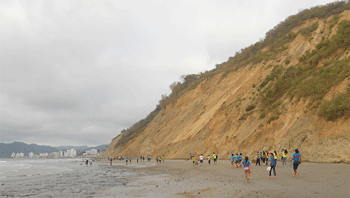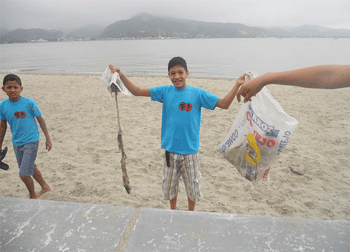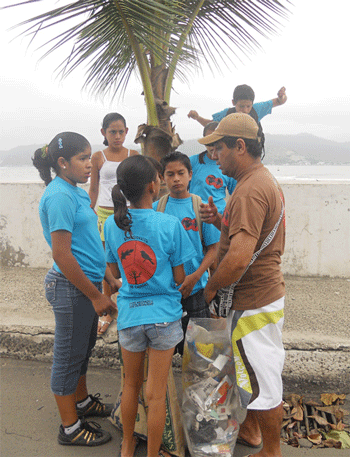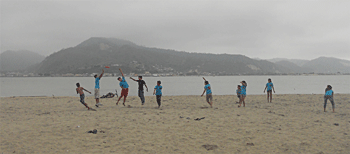Bioregional Education Program
Progress Report 2010
Group B Profesor: Nadine Flexhaug
Assistant: Roberto Rodriguez
Photos below.
The students began to arrive to the first class and the start of the new year in the Bioregional education program with excitement and anticipation. The students were enthusiastic about the excursions to come, meeting their professors, and to hear about all the new things they would soon learn.
We chose a nice spot on the grass and together with my assistant, Roberto Rodriguez, we all sat down in a circle and began to introduce ourselves. The students told us a little about themselves and their motivation for joining the program. I was delighted to hear their reasons – to learn more about how to take care of the environment, how to reduce contamination, and to experience more of the bioregion which they live in (through the weekly excursions). Some students already had some basic knowledge regarding what the program is really about and the others with open minds and a young, energetic spirit listened attentively while Roberto and I explained.
The students began taking turns reading the bioregional booklet and volunteered to participate in answering the comprehension questions I challenged them with afterwards. We broke the ice with a fun game called Tala de arboles, where one student was elected the ¨Lumberjack¨ and the other the ¨Tree hugger¨. The lumberjack chased the students and when someone was touched, it was as if the tree had been cut. The students fell to the floor and could not be revived until the tree hugger came and gave them life. It took three touches from the tree hugger to finally bring the fallen tree to its feet. We played a few rounds, each time adding another tree hugger to see the difference of how many trees were left standing at the end, with the respective amount of tree huggers saving the trees. Later, we spoke about these observations with the kids and I saw that it awakened a new awareness in them of how fast we can destroy the forests and how long of a process is necessary to restore them.
Afterward, we continued to talk about what a Bioregion consists of. Now that the students felt more confident with us, they asked several questions and classmates that knew the answers enthusiastically helped to explain.
The following Friday we went on our first excursion to The Cross. Together as a group, some hand in hand, we walked up to the cross. We talked about the different types of vegetation we saw along the way and pointed out the reforested areas done by Planet Drum. Admiring the view over the city of Bahia, we had the perfect opportunity to point out what we had covered on Wednesday – the different characteristics of a Bioregion.
Going back down the stairs at the end of the day, it was clear that everyone enjoyed themselves as the students asked me, ¨And where are we going next week. Teacher?¨
The next week we continued on the topic of “what is a bioregion?” The students interviewed each other to find out more about who their classmates are and what their inspirations were regarding the program. They shared their answers with the group and despite the embarrassment of a few, the group became closer and more united.
It has been really interesting to see how the group has developed over the past few weeks that we have spent together. Although we only see each other twice a week, we have quickly become like a little family. I noticed immediately that the first few classes the students were a little hesitant at accepting each other as equals. Having already known each other from school, some resentment and negative past experiences with each other were carried over to the program. I was a little unsure of how things would develop in the following weeks and hoped this wouldn’t cause any problems. However, to my surprise this quickly changed. I’m not sure exactly when things shifted, but through the various excursions we made and the games played in the park after class, the students began to form a special bond, not only with each other, but also with Roberto and me. In the following weeks, we covered many other topics including: soil, flora, land ecosystems, etc. and the students began to help and encourage each other with completing the corresponding tasks.
There have been two separate occasions when a problem arose within the group. One was in the park at the end of class, and the other was during an excursion to the lookout in the Bellavista neighborhood. In both cases, first the kids had placed the blame on one particular student and one student even missed a few of the following classes because of it. However, he returned to the classes and now it’s as though neither of the two incidents ever happened. The students who didn’t get along before now choose to work together and enjoy each other’s company.
We have had two new members join our group in the past few weeks as well. They both arrived with a great energy and the motivation to learn. The other students welcomed them with open arms and they have brought even more enthusiasm to the classes. Despite the few minor complications in the past, the group today is one, cooperative and inspired team of ¨Bioregionalists.¨ They take pride in themselves when they do something positive for the environment and when they answer a question correctly.
I remember the first excursion we did, to the Cross. We had seen garbage thrown onto the floor by one student or another from each group; they stumbled upon little plants and generally weren’t very conscious of the environment which they live in. However, now each student is quick to put their garbage in their pockets or pick up the garbage of someone else before we even notice. They are inspired to plant trees and care for them and really have a different mentality in the way they interact with the bioregion.

When we went to the Bellaca beach, the kids were very respectful to the environment and enjoyed the best it has to offer. A few of the girls in the class were a little hesitant about the long hike to the beach they had in front of them and before we had even begun the climb up the

road they complained, ¨My legs hurt, I can’t do it.¨ But with some encouragement from their classmates and the promise of a bath in the ocean upon arriving, they were easily motivated and even ended up running near the end to get to the water first!

We pointed out the names of certain native plants while we walked, like the Ceibo and Guayacan. We were lucky enough that day to see the cotton which had fallen from a giant Ceibo tree on the side of the road. Before I even had the chance, the students commented on all the different things you can make with the cotton.
They brought food, cleaned up after themselves and despite the cold weather, with all the energy they had accumulated along the way, we all jumped in the ocean and enjoyed a nice swim and played some water games.

More classes at the beach:




Unfortunately we have had a few classes with pretty low attendance. Many of the students were pulled out of classes by their parents. The majority because of their bad grades in school. As a result the kids were devastated. One student asked me to call his parents and tell them to let him come to class and I even had one parent comment to me that her daughter was putting more of a priority in the bioregional classes, than in school. Luckily, almost all the students have come back to the program and now they feel that it’s a great privilege to be able to attend the classes and they really appreciate the time we do have.
With the program more than half way through, it makes me sad to know that classes will soon be over and I think the kids feel the same. However, with the open house coming up, I know there are still many more opportunities to share with the kids and work together to bring a change to Bahia, and the mentality of it’s people. The students have shown an exceptional amount of enthusiasm in doing a good job and selecting a unique, interesting project for the open house and I am excited to see how the project will develop.

Your point of view caught my eye and was very interesting. Thanks. I have a question for you.